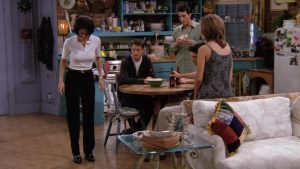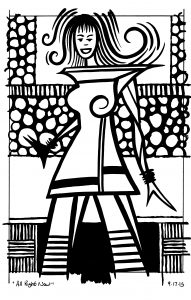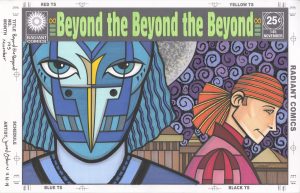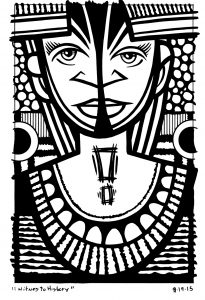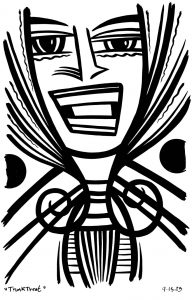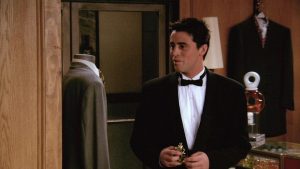I am trying something new today. I’m going to watch a episode of “Friends” on my commute and write about it as I watch. Right now I’m sitting in Secaucus Junction train station and I have a while to wait for a train. I’ve spent plenty of time drawing in my ink book at this train station but I’ve never tried writing. We’ll see if that’s doable or not.
I’m going to be watching one of episodes from Netflix. I’ve already downloaded it when I was back home so I don’t need to be connected to anything to watch it. The episode is from season two and it’s episode three. “The One Where Heckles Dies.” I know from looking at my 2012 ratings that I gave it five out of five stars. That’s a rare rating for me especially in these early seasons. It’s the very first episode of the series that I gave five stars to so I’m looking forward to it.
We start out with a good ensemble scene with the six friends. They set up the first plot of the show (there are usually three plot lines per episode in any given sitcom) as they tell us that Chandler broke up with a woman over what could be viewed as a triviality. It obviously wasn’t trivial to him. Joey is on Chandler’s side which leads us into a solid “Joey is not that smart” joke. I’ve heard complaints over the years that some of the humor in “Friends” hasn’t aged well because we’re not supposed to make fun of groups of people anymore but I’ve never heard anyone say that making fun of dumb people is wrong. I think that’s because no one likes to include themselves in that group.
The theme song sounds good on headphones.
The next scene continues the Chandler bit until Mr. Heckles shows up to complain that the friends are walking too loud. I remember watching this show first run and being surprised that they killed off Heckles (we didn’t know the names of the episodes back then). He was a solid character and sitcoms just didn’t kill off characters very often. They still don’t. Now they’ve all doing Janice impressions. I always liked Janice. She may have had an annoying voice but she was fun. Joey’s impression brings down the house.
Mr. Heckles sudden death in the middle of an upstairs/downstairs foot stomping fight with the women still cracks me up. Now we head down to Mr Heckle’s apartment as they bring him out on a gurney. A very funny transition. Comedy and death are like chocolate and peanut butter. They go together in tasty way but you can upset your stomach if you eat too much of it.
Back up to the friends’ place and Phoebe is being her weird self and sensing Mr. Heckles. That’s when she’s at her funniest. Then she hits Ross right where she knows to get him. Phoebe says she doesn’t believe in evolution thus setting up the second plot of the show.
They’re at the living room coffee table a lot this episode. Just an observation.
Here comes Mr. Heckles attorney to let them know that he left all his stuff to Monica and Rachel (the noisy girls upstairs). They’re a bit surprised but are up for some inheritance. In the next scene they’re in Mr. Heckles messy apartment. All the stuff he left them is worthless but they go through it anyway. We get a call back to a scene that was cut out of an earlier episode as Joey stands in front of an old time TV magnifier that magnifies his crotch. I still love that gag.
Ross won’t let the Phoebe not believing in evolution thing go. He earnestly wants to convince her. She plays him perfectly.
Chandler finds Heckles “Big book of grievances” and we’re back to the Chandler ending up old and alone plot. Rachel wants some tacky lamps that Monica will never go for (setting up plot number three). We’ve got a conflict coming up. And now it’s Heckles high school yearbook. This’ll wind Chandler up. Heckles was voted class clown and so was Chandler. The coincidences continue until Chandler is having a meltdown.
New scene still in Heckles’ apartment and Chandler is inconsolable and he’s spent the whole night there. He’s been finding ways he and Heckles have behaved alike. Including breaking up with women for slight reasons. Heckles kept notes about it. I love the “Pronounces it suposably” joke with Joey later trying to figure out if that’s correct or not. This whole Joey and Chandler scene is top shelf. All good stuff from start to finish.
Short and dramatic scene with Chandler on the phone. How will this pay off? It’s Janice!
Now we’re in Central Perk for the first time this episode. No one can believe he wants to start things up with her again. Nice suits on the boys. And Janice walks in. Pregnant. She’s also married but has a good sense of humor so she just had to show up when Chandler called. I like this bit a lot. Janice is very funny and likable in it.
Now we’re back to the girls’ apartment and Rachel has her lamp. Monica really doesn’t like it. And here comes Ross one more time to try and convince Phoebe that evolution is real. She gets the better of him in a very funny way. Monica breaks the lamp! In comes Chandler all upset and with a “Crazy snake man” plan. They are hitting all three plots in this one scene. The girls are doing their best to buoy Chandler up.
Final scene in Heckle’s place. Monica wants Rachel to have another crazy lamp as a peace offering. And now Monica is in front of the TV magnifier. I never get tired of laughing at that gag. That’s why I’m okay with it appearing twice in another episode’s extended edition. Chandler gives a final poignant tip of the hat to Mr. Heckles.
The end credit scene is Chandler trying to and failing to act differently. And we’re out.
I just checked with the Uncut Friends Episodes webpage to see what was missing from theses Netflix cuts and there was a few lines in the beginning that were no big deal but also cut was a lot of the scene at the end where the girls were trying to buoy Chandler up. They were telling him some of the crazy reasons guys broke up when them and there was some funny stuff in there. I’m going to have to go watch that scene in my standard DVD copies.
For a final thought it was tough writing in the train station. It took a lot more concentration than I thought it would. It’s easier to draw in a train station. I don’t know if I’ll try to write there again
